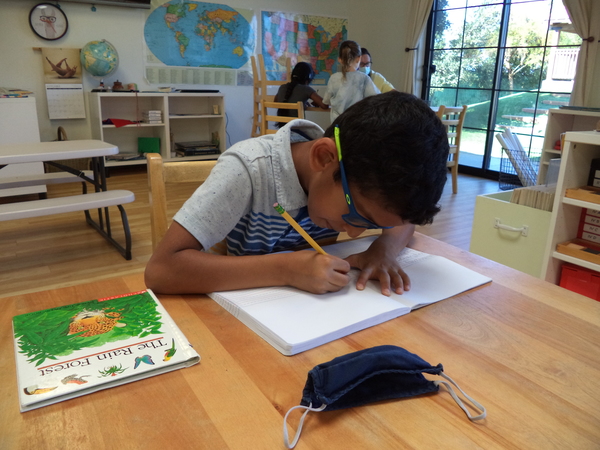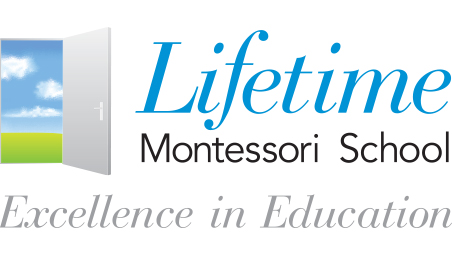(858) 759-0631
How Living Things, Communication, and Numbers Contribute to Each Being’s Job on Earth
Maria Montessori’s advice to educators is simple: “The greatest sign of success for a teacher is to say, ‘The children are now working as if I did not exist.’ Teachers can only help the work as servants wait upon a master.”
“The purpose of life is to obey the hidden command which ensures harmony among all and creates an ever-better world. We are not created only to enjoy the world; we are created to evolve the cosmos,” Montessori said.
The first two Great Lessons examine the universe, Earth, and the life timeline. Starting with the Big Bang, students discover how the Earth was formed and—based on their interests—focus on related topics like astronomy, meteorology, chemistry, physics, geology, and geography. How? Their curiosity!
Once they’ve grasped the concept of the universe and Earth, teachers discuss life’s timeline via dozens of charts and subsequent discussions in Lesson Two. Starting with microorganisms, plants, and animals, students branch out to learn about the diversity of life and the job each living thing contributes to life.
From the first day of class in elementary school, Montessori teachers showed how the universe, life, animals, communication, and numbers came into being to help contribute to life on Earth.
As first conceived by Maria Montessori, Italy’s first female physician, when children are allowed to learn at their speed with their interests at heart, they ultimately take control of their education.
“We must help the child to act for himself, will for himself, think for himself; this is the art of those who aspire to serve the spirit,” she said.
As an outgrowth of her philosophy, she created a curriculum focused on helping each child discover joy in learning. The crux of this learning is the Five Great Lessons—a primer on how everything interacts with everything else.
As Dr. Montessori said, “The child’s development follows a path of successive stages of independence, and our knowledge of this must guide us in our behavior towards him. We must help the child act, will, and think for himself. This is the art of serving the spirit, which can be practiced to perfection only when working among children.”
Here, then, is a breakdown of the five lessons.
The First Great Lesson: Coming of the Universe and Earth
From the first day of class in elementary school, we factually demonstrate how the universe and Earth were formed. Presented in an overview fashion, teachers create experiments that help transform one big lesson into many smaller lessons.
Via 80 large visual charts and corresponding lessons, we focus on each child’s curiosity and enthusiasm to present new topics like astronomy, chemistry, physics, geology, and geography. As students thumb through each chart, they see what they want to learn more about.
Then, they proceed at their own pace to learn more about that topic while watching what other kids do.
Building curiosity, enthusiasm, and inspiration gives students a better understanding of the universe, the Earth, and its interlocking scientific components. And when your child discovers something independently, it stays with them and becomes imprinted into a more thorough understanding.
This sense of self-discovery is essential to the Montessori Method’s lifelong learning strategy. When knowledge becomes imprinted or embedded, it has more impact.
The Second Great Lesson: Coming of Life
Every living thing has a job to contribute to life on Earth. From a visual timeline of life that breaks down eras, evolution, extinction, and the like, we learn about dinosaurs, animals, plants, and microorganisms—and how they connect via topics and experiments.
For example, let’s talk about photosynthesis. In one chart, little men are working in a factory. Some are working in the root system to see how plants mine nutrients. Others are absorbing leaves from the sun and taking out oxygen. Ultimately, CO2 and plant growth is explained by each man’s job.
The outgrowth of the Second Great Lesson: teaching the diversity of life via biology, botany, and habitats.
The key to The Montessori Method is the individual child—a child who can work at their chosen speed under a highly experienced teacher who knows a little about everything and many ways to inspire a child. This fundamentally differs from faith-based elementary schools and the ‘unified school system’ concept of group, rote learning.
Look at the elementary school curricula taught in Great Lessons Three, Four, and Five.
The Third Great Lesson: Humans Come to Earth
What makes man unique? How did we evolve from living in caves and creating fire to fashioning tools and machines? What does man possess that animals don’t, and what makes us different?
Montessori teachers focus on these age-old questions to unlock the creativity in each child’s mind.
And, yes, our minds, hands, and emotions have helped separate us from all others.
Through discovery and invention, human beings have become the dominant species on the planet. Man has built a vibrant history from tools, farming, and food preparation/storage to shelter, transportation, medicine, art, and spirituality. Most importantly, children learn to understand their existence, their place in the world, and their responsibility in bettering society and the universe.
The Fourth Great Lesson: Communication and Writing
Human beings have always used language, pictures, and symbols to communicate with each other. From grunts and hand gestures to the advent of the written alphabet and the printing press, man has always sought ways to create a written record of what he sees and feels.
In the Fourth Lesson, Montessori teachers detail the study of folk stories, mythology, language, alphabets, grammar, sentence structure, and word study. From cave paintings to Egyptian hieroglyphics to Greek and Latin letters, the lesson allows children to focus—as they see fit--on reading, writing, and language.
Maybe that starts with the word ‘and’—a word that binds sentences together.
Or, maybe words are cut up so students can learn the process of word analysis.
In every instance, however, we are communicating together.
The extended lesson: we can understand human beings through shared history, stories, literature, poetry, and music.
The Fifth Great Lesson: Numbers
The common language of the human race is mathematics. Over our 30,000-year history, man has built a system of numbers that has evolved from concepts of zero and one to arithmetic to geometry and ‘to infinity and beyond.’
The story of numbers helps students branch out to learn about the applications of these numbers in such arenas as the invention of the calendar, systems, and units of measurement, and economic geography.
Summary of the Five Great Lessons
In the Montessori setting, lessons arouse enthusiasm. Via demonstrative overviews, our teachers seek to engage excitement and curiosity so children can explore independently.
This is the crux of the Montessori Method elementary school philosophy—children working at their speed with highly experienced, specialized teachers who give them the freedom to succeed at their level.
In a world of public school rote learning or faith-based creationism, the Montessori Method provides your children with an elementary curriculum designed to let them grow at their own pace.
This is the Montessori Difference—seeking to create curious kids who grow into lovers of life-long education and understand how everything is woven into the fabric of everything else.

